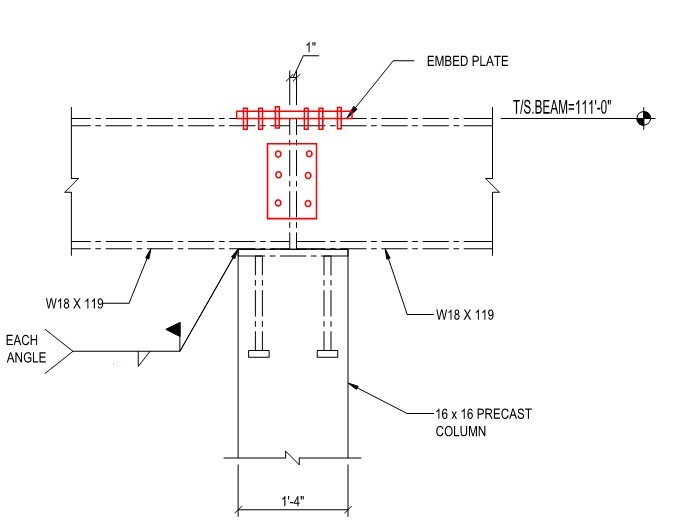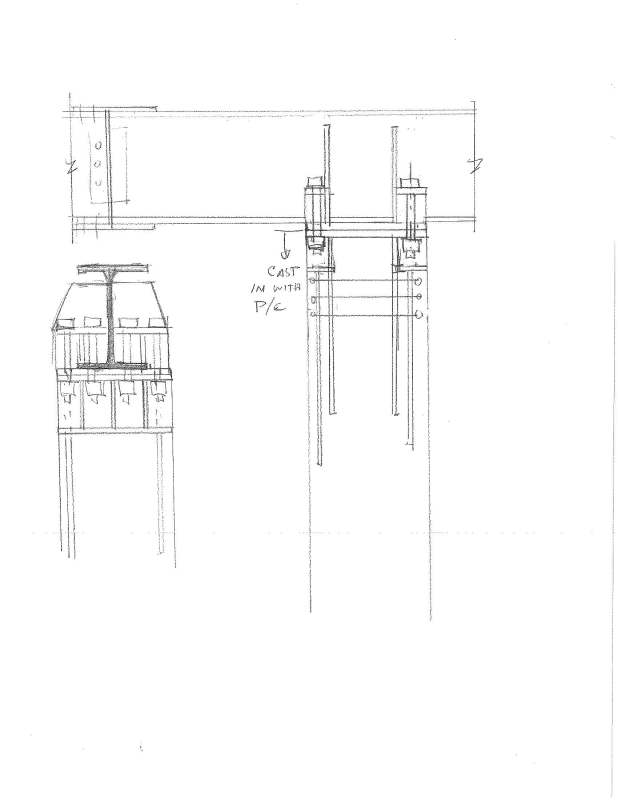MindofBarca
Structural
Hello All,
I have a design question for those familiar with precast and steel connections. I am designing the precast concrete for a 2 story podium style mixed use building. On the exterior of the building I have some precast columns which are supporting two wide flange steel beams. These connections have been called out by the EOR to be moment connections. I am looking for some advice/guidance as to how these members should be connected. The original detail the EOR called out for was simply extending the precast columns up to TOP OF BEAM elevation and butting the wide flange beams into a cast in embed in the precast columns. The problem with this detail was getting my studs to work in shear (I hadn't even got to the moment design issue). In discussing with the EOR we decided to drop the TOP OF PRECAST to BOTTOM OF STEEL BEAM and sit the wide flange members over the top of the column (with a 1" gap between both beams). This eliminated the need for two cast in embeds in the face of the columns. Now I just have to figure out (hopefully with your help) how these members are connected. Can I simply cast in an embed to the top of the column and weld the wide flange members to the column plate? Will this satisfy the "moment connection" needs?
Here are some examples of the loads to get a better feel for the project:
- 18x18 precast column
-Shear= 100-150kips (per beam)
-Moment = 290 k-ft
It's also important to note, most of the columns we typically design are simply supported, K=1.0, type columns. Does this change my column base connection?
Thanks in advance,
jReck
I have a design question for those familiar with precast and steel connections. I am designing the precast concrete for a 2 story podium style mixed use building. On the exterior of the building I have some precast columns which are supporting two wide flange steel beams. These connections have been called out by the EOR to be moment connections. I am looking for some advice/guidance as to how these members should be connected. The original detail the EOR called out for was simply extending the precast columns up to TOP OF BEAM elevation and butting the wide flange beams into a cast in embed in the precast columns. The problem with this detail was getting my studs to work in shear (I hadn't even got to the moment design issue). In discussing with the EOR we decided to drop the TOP OF PRECAST to BOTTOM OF STEEL BEAM and sit the wide flange members over the top of the column (with a 1" gap between both beams). This eliminated the need for two cast in embeds in the face of the columns. Now I just have to figure out (hopefully with your help) how these members are connected. Can I simply cast in an embed to the top of the column and weld the wide flange members to the column plate? Will this satisfy the "moment connection" needs?
Here are some examples of the loads to get a better feel for the project:
- 18x18 precast column
-Shear= 100-150kips (per beam)
-Moment = 290 k-ft
It's also important to note, most of the columns we typically design are simply supported, K=1.0, type columns. Does this change my column base connection?
Thanks in advance,
jReck



